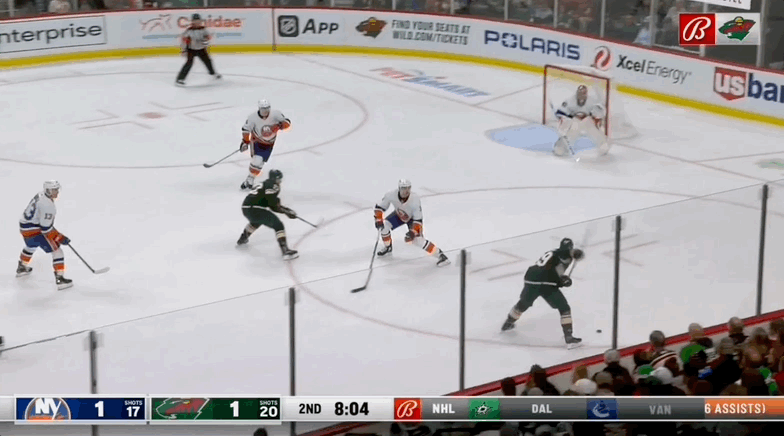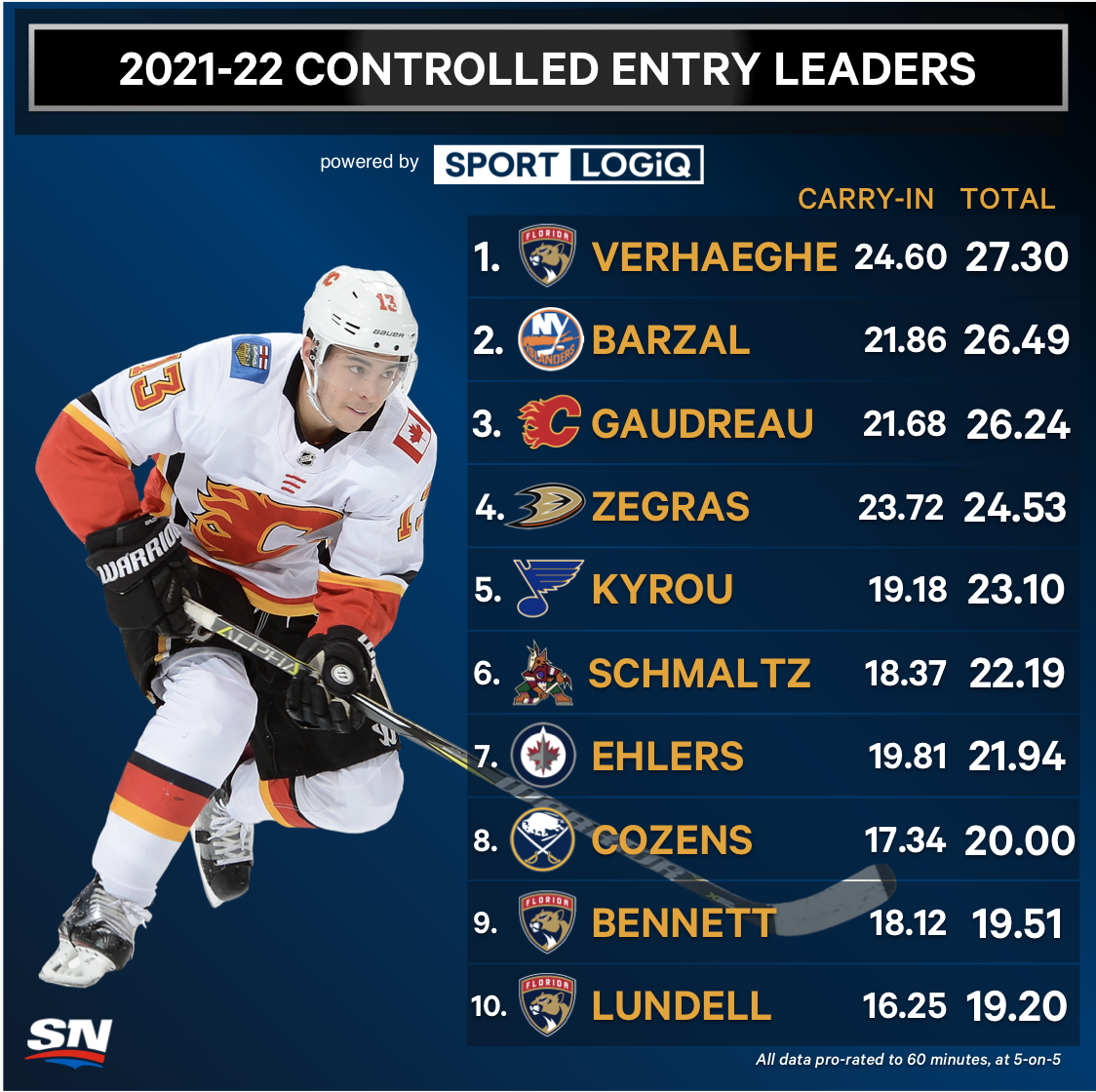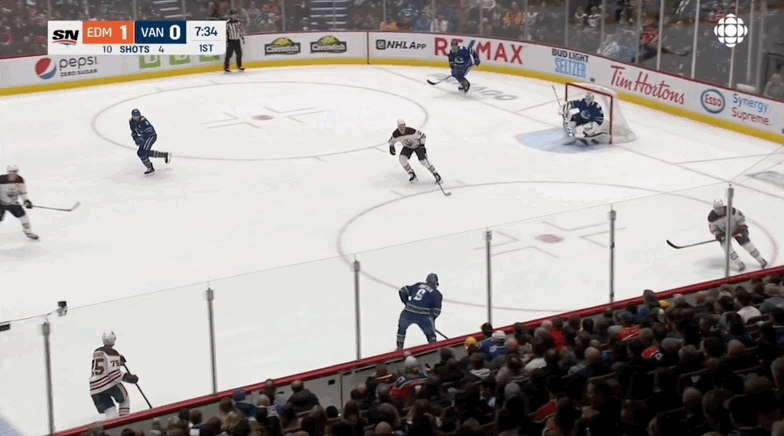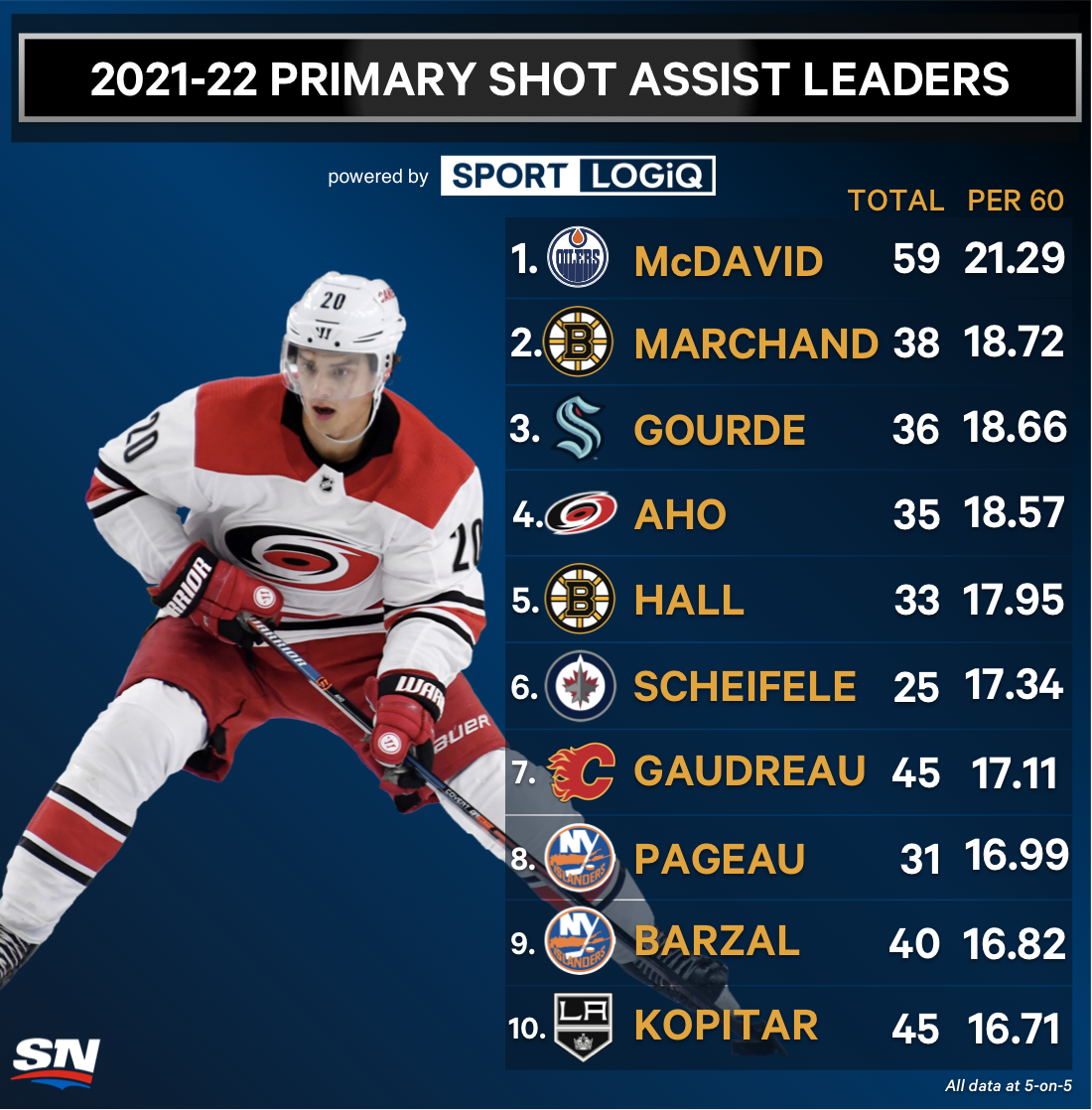Shooters tend to have the spotlight in hockey. Why? Their name is first on the scoresheet. Their tallies change the score, and potentially the tide of the game.
But what about the puck movement that precedes a shot to help make those goals happen?
Let’s talk about some of the best puck-moving forwards at 5-on-5 to open the 2021-22 season.
Carrying the puck out of the defensive zone
Moving the puck out of the defensive end often falls on defencemen, as the Erik Karlssons, Roman Josis, and John Klingbergs are among the best in the league at crossing the blue line with possession.
But forwards contribute to exits, too — some more than others.
Small samples can inflate a player’s rates, since it magnifies so few results. That’s why players like Valeri Nichushkin and Jack Hughes lead the way for carry-out attempt rates among forwards despite not playing much yet this year.
If we remove those players with lesser playing time in the early goings of the season, Mathew Barzal jumps out with 17.7 carry-out attempts per 60 minutes. What’s even more impressive than just his ability to skate the puck out of his own end is the high rate of successful plays that follow those attempts; almost 86 per cent of his carry-outs have been followed by a successful play.

Nick Cousins (17.1 per 60), Kyle Connor (16.0), Jake Evans (15.8), and Dylan Cozens (15.8) are among the forward leaders in carry-out attempt rates at 5-on-5. Cousins, along with Ondrej Kase, Frank Vatrano, Adam Gaudette, and Leon Draisaitl all follow Barzal’s high rate of successful plays after attempting to carry the puck out of the zone.
Entering the zone with possession
Sometimes defenders also lead their teams into the offensive zone. Josi, Cale Makar, and Adam Fox are among the best puck-moving defenders when it comes to zone entries. But most defenders don’t stack up to forwards with possession plays into the offensive end.
Carter Verhaeghe, who had a breakout season last year with the Panthers, leads all skaters with 24.6 carry-in attempts per 60 at 5-on-5. One of this season’s top young guns, Trevor Zegras, finishes right behind him with 23.7 attempts per 60. Barzal, a transitioning wiz, unsurprisingly lands in third with 21.9 attempts per 60.

In Calgary, Johnny Gaudreau’s contributions go further than his team-leading 14 points. He helps their offence click by frequently trying to skate the puck into the offensive zone (21.7 per 60). Nikolaj Ehlers in Winnipeg completes the top-five with 19.8 attempts per 60.
Carrying the puck in, of course, is just one part of the equation. It’s crucial that a team also extends that sequence to create offence.
Verhaeghe jumps ahead with a high rate of successful plays after a carry-in attempt, followed by Ehlers and Gaudreau. Jordan Kyrou, who is in the top-10 in carry-ins, and Barzal rank in the top-five as well.
Connor McDavid carries the puck into the offensive end quite frequently, but when weighing his hefty ice time, his per-minute rate slides to 11th. That said, when it comes to a carry-in followed by a shot on goal, no one ranks higher right now than Edmonton’s captain. Gaudreau and Sam Bennett also see their entries convert to shots on net quite often.
Further than just a shot, since shots aren’t all created equally, we can look at scoring chances that follow a carry-in. That’s where Verhaeghe thrives in Florida. Gaudreau and Zegras also help spark their team’s quality chance generation with their carry-ins.

Of course, skating the puck into the offensive zone isn’t the only way to bring it in with possession. Forwards also create a controlled entry with a pass over the blue line. Leon Draisaitl passes the puck into the offensive zone for a controlled entry at the highest rate in the league (4.74 per 60).
Robert Thomas follows the Oilers’ offensive dynamo. Between his passes and linemate Jordan Kyrou’s controlled entries (particularly his high rate of carry-ins), the Blues’ current second line is quite skilled at gaining the offensive zone with possession.
Barzal and Gaudreau, once again, find themselves high on this list for another transitional play. And Jason Spezza makes his debut to round out the top-five in pass entry rates.
So, to put all this together, we can look at the players who best bring the puck into the O-zone with control between carry-ins and passes. Since carry-ins happen at a much higher rate, the top-five remains the same. But to expand to the top-10, we see players like Cozens who, like Barzal, also contribute with zone exits. Plus, we see a few more Panthers emerge.

Passing plays leading to scoring chances
Transitional play obviously influences offensive generation, but doesn’t always directly impact a shot attempt. A primary pass, on the other hand, does. There’s value and repeatability in using primary shot assists to help predict future scoring, as the work of Ryan Stimson with The Passing Project shows.
So which forwards help set their teammates up for a shot the most?
Of course, it’s the generational McDavid leading the way with a rate of 21.29 primary shot assists per 60, or passes that directly precede a shot attempt.

There’s a bit of a gap of over two passes per 60 between the best two in the league in this regard, with the margins slimming out from there. Brad Marchand’s 18.72 primary passes per 60 to his linemates is good for second. That obviously clicks well with one of his more frequent linemates, David Pastrnak, who uses his accurate shot often in Boston.
Yanni Gourde, Sebastian Aho, and Taylor Hall round out the top-five in primary shot assists. Last year, Hall shot the puck at the lowest rate of his career and this year his individual shot rate is still pretty low. But he’s maintaining his offensive influence through his passing.
A player like Artemi Panarin is expected to be in the top-10 with his passing. But while his raw passing totals land him second in the league, he isn’t creating at a high enough rate in his minutes to compare to some of the aforementioned forwards. Instead, Panarin is currently 11th in the league in primary shot assist rate after getting off to an iffy start this season.

Shot assists are obviously broad, and different types of passes have varying impacts. So, we can look even deeper at these forwards’ passes.
Zegras and Thomas both set their teammates up at a high rate off the rush. Travis Konecny and Mark Scheifele tee up their teammates for one-timers at the highest rate. Two Western Conference players lead the way with passes to the slot in Sonny Milano and Draisaitl, although there’s quite a bit of difference in talent between who they are passing to.
To get even more specific, we can look for a royal road pass that directly precedes a chance from the home plate area in front of the net. Alan Wells found that these types of passes had a 15.5 per cent finishing rate when analyzing Stimson’s data from the Passing Project. The danger of a royal road pass, especially if it sets up a one-timer or a quick shot attempt, is that it forces a goaltender to move laterally. So that pre-shot movement, particularly with the right amount of deception from the attacking team, can trick defenders and goaltenders and lead to a quality chance.
In his 75 minutes of play, Dylan Strome actually rates the highest in the cross-seam passes that result in a scoring chance from the slot area with 4.79 per 60. But that passing obviously hasn’t been enough to keep him in Chicago’s lineup.
Marchand, in a few more minutes (~122 at 5-on-5), ranks second with 3.98 royal road shot assists per 60. That ability to thread his teammates with a quality pass — especially to one of the most dangerous shooters in the league in Pastrnak — can make the Bruins’ offence so dynamic when Marchand’s on the ice.

Tyler Bertuzzi currently is in third in this stat, and his linemates — Lucas Raymond and Dylan Larkin — have benefitted from it to start the season (at least, until they cross the border). Kyrou is fourth, while Nathan MacKinnon, one of the ultimate dual-threats in the league, rounds out our top-five.
All 5-on-5 data via Sportlogiq, collected prior to Monday night’s matchups.


 2:53
2:53
 1:38
1:38
COMMENTS
When submitting content, please abide by our submission guidelines, and avoid posting profanity, personal attacks or harassment. Should you violate our submissions guidelines, we reserve the right to remove your comments and block your account. Sportsnet reserves the right to close a story’s comment section at any time.